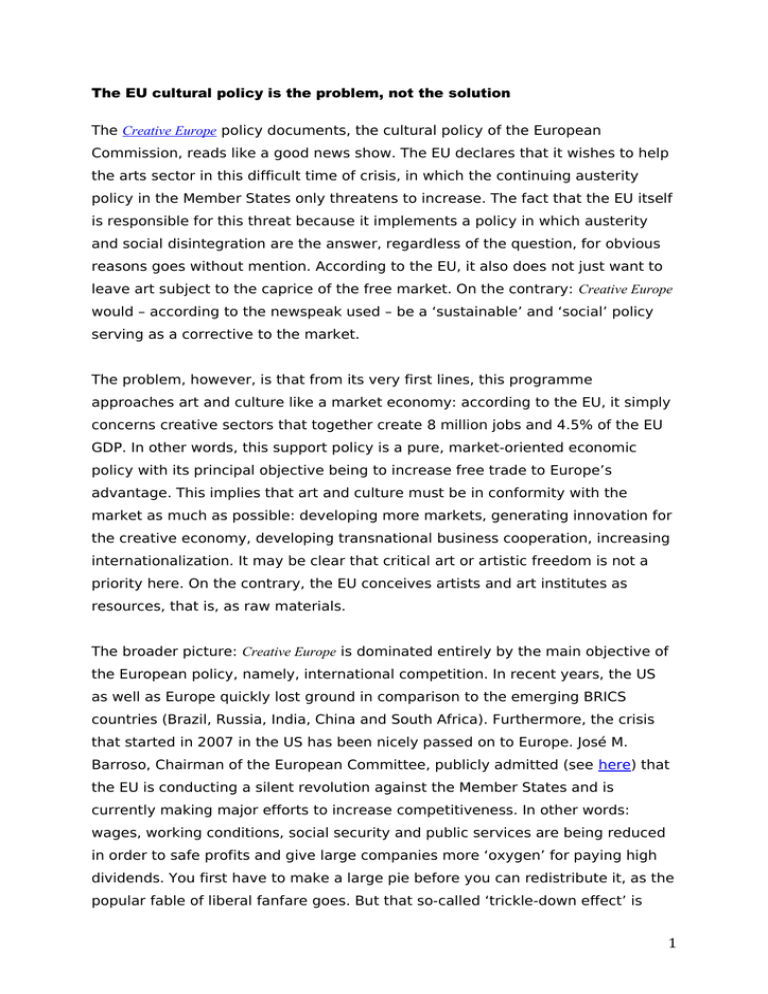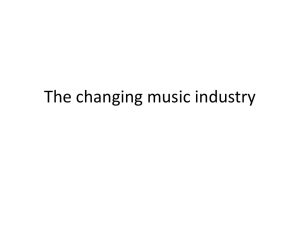EU cultural politics is the problem, not the solution
advertisement

The EU cultural policy is the problem, not the solution The Creative Europe policy documents, the cultural policy of the European Commission, reads like a good news show. The EU declares that it wishes to help the arts sector in this difficult time of crisis, in which the continuing austerity policy in the Member States only threatens to increase. The fact that the EU itself is responsible for this threat because it implements a policy in which austerity and social disintegration are the answer, regardless of the question, for obvious reasons goes without mention. According to the EU, it also does not just want to leave art subject to the caprice of the free market. On the contrary: Creative Europe would – according to the newspeak used – be a ‘sustainable’ and ‘social’ policy serving as a corrective to the market. The problem, however, is that from its very first lines, this programme approaches art and culture like a market economy: according to the EU, it simply concerns creative sectors that together create 8 million jobs and 4.5% of the EU GDP. In other words, this support policy is a pure, market-oriented economic policy with its principal objective being to increase free trade to Europe’s advantage. This implies that art and culture must be in conformity with the market as much as possible: developing more markets, generating innovation for the creative economy, developing transnational business cooperation, increasing internationalization. It may be clear that critical art or artistic freedom is not a priority here. On the contrary, the EU conceives artists and art institutes as resources, that is, as raw materials. The broader picture: Creative Europe is dominated entirely by the main objective of the European policy, namely, international competition. In recent years, the US as well as Europe quickly lost ground in comparison to the emerging BRICS countries (Brazil, Russia, India, China and South Africa). Furthermore, the crisis that started in 2007 in the US has been nicely passed on to Europe. José M. Barroso, Chairman of the European Committee, publicly admitted (see here) that the EU is conducting a silent revolution against the Member States and is currently making major efforts to increase competitiveness. In other words: wages, working conditions, social security and public services are being reduced in order to safe profits and give large companies more ‘oxygen’ for paying high dividends. You first have to make a large pie before you can redistribute it, as the popular fable of liberal fanfare goes. But that so-called ‘trickle-down effect’ is 1 clearly a false promise when in the meantime it appears that lot of efforts are done to dismantle the welfare state, job security and labour conditions. Due to the desire for competitiveness, the EU exerts control at two speeds: there are the northern countries with a surplus, and the southern countries with debts, which ever-increasingly relate to one another like jockey and horse in a race to the bottom. Those who stand up for a social or cultural Europe are facing a losing proposition: the battle with countries such as Bangladesh also cannot be won without catapulting Europe back to the middle ages. In this perspective, the EU has also now discovered the arts. Unfortunately, nonartistic objectives are central to this. Not only must art institutes become more commercial; they must also, in all their aspects, be at the service of the market. One who goes through the EU cultural policy point by point also discovers that a substantial vision on the (artistic or cultural-sociological) role of art and culture in 21st century society is nearly nowhere to be found. What is found is a pronounced, even revolutionary market economic vision, including its own holy trinity: (1) the transformation of art and culture into the so-called ‘creative industry’, (2) the reorientation of and cutbacks to the public art and culture sectors by means of a referral to the market, (3) promotion of the role model of the artist-entrepreneur. The myth of ‘creative industry’ and the ‘spill-over effect’ First finding. From nearly every policy document of Creative Europe it appears that maximum efforts are being made to sell out the arts sector to the creative economy. The public cultural sector serves in this regard as small change. The sector is becoming ‘seed money’ – a term from the EU documents – for the market. Not only must cultural centres attract ‘investors’, after which the authorities can eventually withdraw, but along with this changing of the guard they must also develop an interesting investment climate for new markets. A notable repackaging operation facilitates this policy-related transition. The EU has combined the Media and Culture budgets into a joint budget of 1.46 billion euro – which stirs the imagination – of which, however, a minimum of 31 percent and a maximum of 34 percent can go to ‘culture’. That would be an average budget increase of 9 percent for Media as well as Culture in comparison to the previous round (2007-2013). 2 However, it does not mention that it now concerns more countries (also friendly, non-EU countries or cities are eligible) and also many more sectors. What is crucial is that from now on the EU in fact no longer speaks about ‘art’ or ‘culture’, but about ‘cultural and creative industries’, and this collection is so flexible that it becomes difficult to find a sector that is not directly or indirectly eligible. The arms industry, for that matter, is undeniably a very creative sector. Due to these conceptual acrobatics, the arts thus become submerged in the white-water rafting ride of market-oriented innovation. The problem consists of the fact that the EU wishes to promote the creative economy at the expense of the cultural sector, for art is obviously something other than creative economy. Of course, there is also nothing wrong with design or other applied arts, particularly not if they receive space to develop within a public sector through and by the community. But it is telling that in these times of social and ecological transition for such important innovative sectors, no separate, appropriate cultural policy independent of the commerce and ‘copyright industry’ has been developed. The ‘sustainability’ about which the EU speaks thus concerns sustainable, profitable market relations. The misleading nature of this cultural policy also reveals itself in the metaphors that are used along with the new applicable concepts. For instance, EU policy makers like to refer to what they call the spill-over effect.1 Their plea then begins by waving incense toward the art world, at that vibrant cornucopia of what in the business world is called ‘research and development (R&D) – something that companies, due to the pressure of dividends from the financial markets, can in fact invest in less and less, and therefore want to outsource to public sectors such as education and culture. The EU wishes to assume an exemplary role in this regard, and coerces the Member States to march along in step. After the incense then, the question soon follows as to why so many potential applications just spill out of that horn of plenty, remain as it were completely unused, and are lost. 1 This is more or less the central, motivating keyword of Creative Europe. The European Commission Green Paper (COM (2010) 183) in this regard mentions as one of the three central challenges, for instance: “To move towards a creative economy by catalyzing the spill-over effects of CCIs on a wide range of economic and social contexts.” – p. 4 (their emphasis). “Through these spill-over effects, Europe's CCIs offer a path towards a more imaginative, more cohesive, greener and more prosperous future.” – p. 3 (The other objectives: helping the global presence of local and regional CCIs; increasing the capacity of entrepreneurs by, among others, providing easier access to funding). 3 Who can be against a policy that encourages spilling some of this plenty over the boundaries of the sectors? Unfortunately, this charming presentation of the state of affairs highly distorts reality, as Creative Europe rather aims to tear down the boundaries between the public and private sectors, its goal being a market that is “unified and common, without borders”. It thus does not so much concern the recycling of a spill-over, but an outright damming off at the source. Or, to stay within their metaphor: this policy is indeed dedicated to a spill-over effect, but then in the other direction. It provides for an influx of commercial practices and business models such that the field in which the artistic and social imagination should be able to take root becomes flooded. What floats to the surface must then still be applied to non-artistic objectives. In this way, it is possible to work on the marketing of the cultural sector on all fronts as the same time. It inevitably leads to the dilution and even evaporation the intrinsic values of art and culture, including the reclamation of unique and carefully constructed cultural traditions. This might be difficult to conceive from our current logic of consume and discard, but what disappears of cultural riches simply never comes back again. The hold-up on what could be “cultural entrepreneurship” Second finding. Under the guise of a support policy, the EU is imposing a cultural policy that can be summarized in two verbs: privatize and market. From the previous, it already appeared that the EU is using its own terminology with a view to a paradigm shift in thinking about cultural policy. With regard to art institutes and cultural subsidies, in this way it introduces a cultural policy that focuses on a discourse of ‘self-government’ and ‘return on investment’. With this, it promotes a very narrow view of cultural entrepreneurship that focuses on two issues: public sectors are systematically referred to the market as well as deployed as the engine of market development. The corresponding policy vision moreover presents itself as a Russian doll: according to the new style of subsidies, which directly promote entrepreneurship and public-private partnerships, the old ‘passive’ subsidies are ‘earmarked’, as that is called in the liberal vernacular. That is to say: you will still receive it, but on the condition that you can 4 demonstrate that your organization, for instance, realizes a quota of privatization by means of crowdfunding, or that these investments generate a return. In terms of city marketing, for example, or spin-offs in the entertainment industry. Or serve as a model for a creative investment climate, and thus as a calling card for companies. ‘Self-government’ in this way gradually becomes the new norm (read: ‘creative’ and ‘smart’ management by means of all sorts of commercial deals). By merging the cultural policy for Media and Culture, the arts sector, for instance, must also inevitably adapt to management models that are standard in this profit-oriented media business. This major disadvantage with regard to the management culture is naturally difficult to express in figures, but in nearly every art institute, the increasing attention for marketing and public relations is already extremely evident. Alas, proportionally, more and more resources are dedicated to this, such that institutes are going to act like companies competing with one another, riding on their own behalf, and threatening to lose sight of their basic task – artistic presentation or support. A policy that would commit to artistic collaboration and international networking in service of the artist is naturally something to encourage. But the EU uses this lovely promise as a pretext for expanding an institutional network aimed at developing new markets. For instance, according to Creative Europe, it would provide funding “for at least 250,000 artists and cultural professionals, 2,000 cinemas, 800 films and 4,500 book translations.” How one arrives at these figures before the first application has even been submitted is a mystery – particularly when we note that the subsidy conditions are of such a nature that individual artists are virtually ineligible. To be sure, it concerns artists and something such as ‘cultural professionals’, witch obviously is a very elastic, limitless category. From the Culture application procedures, in fact, it appears that the EU is only interested in large projects that reinforce the transnational or international competence of the ‘cultural or creative sectors’ (such as the establishment of economic networks or platforms). Individual artists are thus only eligible insofar as they can play a role in the subsidy application of businesses or large institutions. Generally speaking, most of the money also ends up there. Artists 5 that are not market-friendly (that do not wish to let themselves be commercialized or are too critical) are out of the picture. Nevertheless, it is precisely they who need support. Consequently, this is not a cultural policy that is committed to artistic development, unless as an incidental side effect or an intentional exception to the rule that functions as a rhetorical lighting rod, but is a policy in conformity with the market, aimed at free trade rather than artistic freedom, at scope and turnover, whereby the artist is systematically driven into the arms of the (major) art institutes, while the art institutes become even more commercially entangled in the creative economy. What is not mentioned, but is very telling: Creative Europe ultimately received only 0.05 percent of the total EU budget. Nonetheless, also this relatively negligible portion of the budget for cultural policy is deployed for the all-important goals of the so-called Horizon 2020 programme: economic innovation and growth. Moreover, the cultural policy is presented as a ‘social’ policy because it is aimed at the creation of ‘jobs’. However, if we would consider using this budget to directly provide a decent income for artists so that they could dedicate themselves fully to art and the community, then this would promptly provide thousands of jobs for the next seven years. Thus, we once again identify the complete confusion of concepts: that which is a market-oriented policy is called a social policy. A true social policy should at least appeal for redistribution on a European scale by means of a modest tax on capital wealth and financial speculation. Why, from the many billions of euros that are removed from the market annually to pay in dividends, could not a fraction be reallocated to, for instance, art and culture? Out of the fear of flight of capital? Are billionaires about to flee the entire EU due to a wafer-thin tax on their astronomical profits? In short, because of this market-oriented cultural entrepreneurship, innovation messianism is now also (and particularly) expected from the public sectors. While the EU highly values ‘creativity’ and ‘innovation’ in the interest of its competitive position in the international economic war, it systematically cuts off the imagination by means of its cultural policy. The result: much art and culture that never will be. We are all the victims of this. The artist-entrepreneur as the new Messiah 6 Third finding. The artist must become an entrepreneur with an innovative attitude that conforms to the market. The business leader that once let himself be inspired by an artist who typically lives in a different, parallel world, from now on will obtain an additional creative colleague. In this way, exchanges between art and economy will become informal chats between similarly minded people who exchange tips about marketing, PR stunts and HRM. The intended inspiring experiment between art and economy thereby degenerates into a rendezvous between artist-entrepreneur and entrepreneur-artist. Because of the discourse of this cultural policy, officials from the public cultural sector, oddly enough, will increasingly assume that an artist must be an independent contractor. The role model of the artist-entrepreneur, which Creative Europe triumphantly puts forward as a saviour of the wretched economy, is put forward to the Member States from the top-down. This is the case because, in its support policy, the EU only considers candidates from institutions in countries whose national government definitively adopts the EU cultural policy as legislator. The ‘big stick’ it wields: ‘punishing’ critical politicians who wish to safeguard the autonomy of their own cultural policy, and thus indirectly a number of their compatriots, who are not artists but can be directly or indirectly labelled as ‘cultural professionals’. Cultural politicians who recognize that the critical capacity of art is of vital importance for social, cultural and artistic innovation, and that a democracy therefore has every interest in supporting its own watchdogs, are thereby checkmated. The commercial versus the critical content of art generally act as communicating vessels. Due to the EU, whoever would eventually dispute this comes to confront the following finding with regard to the reduction of critical art: the EU only support projects that expressly support the objectives of Europe 2020. And you can add Merkel’s austerity politics to this. Specifically: an exhibition with critical comments about the corporate takeover of Europe is in principle no longer possible; even less so is a play about how the democracy of the ‘PIGS’ (Portugal, Ireland, Greece and Spain) is reduced to UNESCO heritage by the EU. And what about the fate of a film that portrays the fact that the EU absolutely does not wish to save Greece, but rather to export the dismantling of the Greek welfare state as a role model to the rest of Europe? Censure, at the very least, by a loss of funding. At the risk of a breach of 7 contract, the self-disciplining of the cultural sector in this way increases even more. [Exit socially-engaged art stage left]. Artists that wish to be eligible for subsidies will unfortunately have to increasingly keep in mind trends and market conformity in their creative process in the hope of being able to reach a large audience, and in this way to eventually have a chance at receiving support. Generally in vain: in the Netherlands, for instance, we have already seen that subsidies promised for what is called the ‘creative industry’ do not end up with artists, stylists or graphic designers, but rather with multinationals such as Philips. Policy makers then sometimes reply with the bromide: “what is wrong with commercial art?” The point of course is cultural subsidies have to be directed there while non-market oriented art is in any case already suppressed. If it depends on Creative Europe, artists must above all provide our economic region with a creative image. In this way the ‘creative person’ becomes an ideological decoy for investors. Artists thereby become increasingly dependent on commercial cooperation so that a wide audience – inevitably – wears them out like a shopkeeper. This is also a problem for the art market: collectors and galleries that intend to continue with artistic works are now being overrun by numerous organized art marketers and fraudulent speculators. The noncommercial art market therefore also needs a strongly artistic public sector, free of all sorts of marketing. Moreover, our society in general needs a market-free cultural sector, probably now more then ever, that is ambitious in terms of system criticism and ideological avant-garde. The power of imagination can show us that there are alternatives thinkable in these complex times. The necessary turnover in cultural policy could be a vanguard for our future society, tailored to people not profit. That’s why the role model of the artist-entrepreneur is a false prophet, even a Frankenstein monster that turns against us, its creator. Since it is also our responsibility to denounce and resist the EU-shock therapy. Still, it looks as if many of our cultural officers or art institutions will enthusiastically embrace this EU policy, and in this way personally put the continued existence of our public cultural sector at risk, among others because it 8 is all presented so sympathetically by the government and all of its sectorsupporting institutions. For there are in fact a great many subsidies to capture, are there not? But the price that the future cultural policy will have to pay for this fact is so high that bankruptcy is a real threat for the culture-supporting policy that has been carefully and painstakingly developed over the previous decades. Conclusion: textbook example of neo-liberal policy According to many policy makers, it would be populist to call this support policy ‘neo-liberal’ because neo-liberalism means, precisely, ‘less government’, does it not? This confusion of concepts is also, however, a fine example of populism…at least in the negative sense of that word: the use of distortions that are continually repeated in public opinion in order to mislead the ‘average person’. Together with its psychological and sociological meanings (e.g. hyperindividualism, increasing competition, blaming victims, loss of empathy, solidarity and love), neo-liberalism indeed has a clearly-defined political-economic meaning: while socialism appeals to more socialization and a larger public sector, and liberalism on the contrary campaigns for less State and more market, neoliberalism stands for bigger government, but then in function of the free market. It is a type of politics that, since Thatcher and Reagan, has rigorously emphasized the same belief around the world for more than thirty years: a support policy for the economy is crucial to create growth. (Read: in order to postpone the systematic crisis of capitalism since 1970, i.e. the crisis of overproduction, for some time.) Creative Europe is a symptom of this. One constant in this cultural policy is the oneway traffic that it establishes ahead of time: from the public sector to the market. Public institutes must, for instance, develop banking expertise in order to able to borrow and invest, whereby they become a plaything of the bank and stock exchange. Subsidies are casually labelled as unfair competition as a means to put pressure on policy makers so that the authorities will also generously support commercial players or reduce support for public funded institutions. The overarching notion is public-private partnership according to the well-known vampire logic: collectivize risk and debt; privatize profit and prestige. In other words, innovative instruments must be developed in the lap of the community 9 that, as soon as they are operational, must provide ‘oxygen’ to the hunt for profit and speculation by the privately wealthy. As riposte, it is occasionally pointed out that the EU is not permitted to implement a cultural policy. This is indeed laid down in a variety of treaties in order to avoid, for instance, subsidizing mediocre euro-pudding like Eurovision Song Contests. But with Creative Europe, the EU de facto implements an art and culture policy. And even if this may only be an economic policy, why then must it necessarily be a policy that conforms to the market, aimed at recycling and redefining the public sector? Why, for instance, may it not be a policy that competes against the market in order to reinforce the socialization of the cultural sector, for and by the community, far away from marketing and advertising? In conclusion, let us not forget that something like the ‘European Commission’ is not democratic representation. Commissioners that are not directly elected draft a policy according to their own belief that is gradually provided with a democratic fig leaf afterwards. Creative Europe, for example, is based on a public survey of only some 300 people from throughout Europe, the majority of who are (their own) policy people. A few artists at most were involved. The only thing that is apparently democratic about the EU policy is the way in which the EU itself organizes its opposition. For instance, the Culture Action Europe platform saw the light of day through sponsoring. This platform, in which a few artists are included as a sort of billboard, has but one demand: a higher budget for the EU cultural programme. Curiously enough, all substantial criticism of this neo-liberal policy is lacking. In other words, the European Commission uses this platform – to which a great many members from the cultural sector unsuspectingly sign their signature by means of petitions – as an instrument to make the European parliament believe that the cultural policy that they propose would have broad support anyways. This makes developing an opposing force particularly difficult. And this is precisely why a platform such as Save our culture! is so important: it works to raise awareness, mobilize and create solidarity among the makers and enthusiasts of culture in the interest of artistic freedom and critical independence. Make a fist: united we stand! Robrecht Vanderbeeken is a philosopher. Email: Robrecht@vanderbeeken.be 10 11







